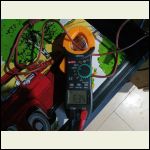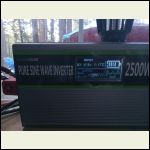|
| Author |
Message |
paulz
Member
|
# Posted: 1 Nov 2022 17:47
Reply
Anyone use a clamp on meter to measure AC? Does each wire carry half the current, so total amps is the sum of the two?
|
|
ICC
Member
|
# Posted: 1 Nov 2022 17:52
Reply
Quoting: paulz Does each wire carry half the current, so total amps is the sum of the two?
Are you talking two wires of a 240 VAC line or the two wires of a 120 VAC line?
120 VAC, measure either wire it does not matter.
240 VAC measure each wire separately. The amps on them could be different ass each hot 240 VAC wire is a separate leg inside the service panel.
|
|
paulz
Member
|
# Posted: 1 Nov 2022 18:01
Reply
120. Each wire is measuring 6A with the toaster on, and I think it draws about 1,500W.
|
|
gcrank1
Member
|
# Posted: 1 Nov 2022 18:59
Reply
I have a Fluke clamp-on for ac, it needs an adapter to split the wires (buy or make one) for many test purposes but is nice.
Wish mine also had dc, didnt foresee having so much dc to deal with!
Get one with ac/dc, you will love the camp-on feature.
|
|
travellerw
Member
|
# Posted: 1 Nov 2022 18:59
Reply
On AC you just measure one wire (not ground). If you are seeing 6A that could be correct depending on the toaster. A 4 slice will be 1/2 the rated current when toasting just 2 slices.
|
|
ICC
Member
|
# Posted: 1 Nov 2022 19:02
Reply
Quoting: paulz and I think it draws about 1,500W.
If that is from the label it is a maximum. In use may be less
|
|
paulz
Member
|
# Posted: 1 Nov 2022 19:14 - Edited by: paulz
Reply
Quoting: gcrank1 Wish mine also had dc, didnt foresee having so much dc to deal with!
I bought it with the intention of doing DC (like measuring solar panels while in operation) but most don't do that, at least not the $30 one I bought..
Quoting: travellerw On AC you just measure one wire (not ground).
And double it for total amps/wattage?
Quoting: ICC If that is from the label it is a maximum. In use may be less
My inverter display says it's using 1,500W, and remember I had to increase the DC cables to keep the toaster from shutting it down. So the 6A I'm getting, times 2, about works out. I just want to make sure I'm doing this correctly, I want to measure the AC stuff in my shop, something down there is hogging battery.
|
|
ICC
Member
|
# Posted: 1 Nov 2022 19:30 - Edited by: ICC
Reply
Quoting: paulz And double it for total amps/wattage?
NO. No doubling for 120 VAC. Measure one wire, either one, and that is your amps.
One of the meters is likely inaccurate. Maybe both.
|
|
|
ICC
Member
|
# Posted: 1 Nov 2022 20:04
Reply
With a 120 VAC circuit both wires, the hot and the neutral have exactly the same current flow. Right down to milliamps the same.
A GFCI works by sensing if there is a difference in current flow between the hot and the neural. A difference of only 5 milliamps will trip a GFCI.
You could measure each wire independently. The reading should be very very close to being the same. If there is no working GFCI in the circuit there could be an imbalance that is measurable. That is not good but it is possible. And you still do not add the amps when measuring a 120 VAC circuit current flow.
|
|
paulz
Member
|
# Posted: 1 Nov 2022 20:09 - Edited by: paulz
Reply
Quoting: ICC One of the meters is likely inaccurate. Maybe both.
Or me. I was going by memory on the inverter display, forgot I switched toasters with the house. It only reads 990W. Meter 6.32A. Off by over 100W. Maybe the inverter counts it's own consumption. Or maybe the 30' of wiring and power strip.
Edit: Moved the test cord to the inverter, 6.45A, so it does lose some over the travel.
20221101_165332.jpg
| 
20221101_165353.jpg
|  |  |
|
|
Fanman
Member
|
# Posted: 2 Nov 2022 06:48
Reply
Current flows in one side and out the other, so the numbers have to match, unless something is wrong. If they didn't match you would expect to see the difference in the ground wire if you clipped the meter there.
As far as one end to the other, if 6A is going in at one end, you have 6A at the other. The voltage may drop due to resistance in the wires, but the current stays the same, unless something else is connected and using power in between.
Think of current as the amount of water flowing through a hose, in gallons per minute or whatever. Whatever goes in one end has to come out the other, unless there's a leak. Think of voltage as the pressure pushing the water. If there's no flow the pressure is the same at both ends, if water is flowing there's friction between the water and the sides of the hose so the pressure at the discharge end will be lower.
The wattage rating on the toaster is probably the maximum startup rating. Heating devices have less resistance when cold, as the heating elements heat up the resistance increases so the current (and thus wattage) decreases. In something like a toaster this happens very quickly, i.e. a few seconds.
|
|
paulz
Member
|
# Posted: 2 Nov 2022 09:59
Reply
Good education for me, thanks guys. Beats working on the toilet. I just flipped the toaster over, rated at 750W, concurrent with my 6.xxA meter readings, which yes are equal on both wires.
The inverter reads 990 while the toaster is going, if it's higher at startup I don't know since it's on the other side of the cabin. I don't see any real need for accuracy with it anyway.
The meter did read differently, as noted above, when I moved it from the toaster to the inverter, 30' apart, 6.32A to 6.45A, for whatever reason. For my needs though, I now know how to measure and compare AC things to each other. Thanks again.
|
|
travellerw
Member
|
# Posted: 2 Nov 2022 11:35
Reply
If its a low cost Chinese inverter, then I wouldn't trust the display at all. I actually have never seen one that was accurate.
I'm guessing your meter is fine, but the inverter is WAY off. (Note - The inverter displays seem to get more accurate the more current you pull)
|
|
gcrank1
Member
|
# Posted: 2 Nov 2022 12:21
Reply
Im thinking that about everything with the inexpensive HF 'Eastern/Pacific Rim' inverters is subject to suspicion.
|
|
paulz
Member
|
# Posted: 2 Nov 2022 13:35
Reply
Definately a cheapo inverter, $200, but it works well despite consuming a couple more amps than a better one. Yeah the display doesn't even come off zero when powering the 42" TV and Roku box, which I think is around 100W. The remote power switch and USB ports were nice extras but I suppose they all have that now.
|
|
gcrank1
Member
|
# Posted: 2 Nov 2022 14:27
Reply
My research has indicated that when the 'serious folks' finally get their expensive Low Freq, HD inverter they usually keep the last surviving cheapie as an emergency backup. They seem to work until they dont, then.....lol.
My 1kW inverter must have failed in its internal voltage regulation and began pumping more than 120vac out. I fried some devices. Looks like few or none of those HF units really have any peak load capability beyond a few microseconds so one has to really upsize for motor or pump start loads. Im considering 'just one more' cheapie at 1500W for short time heavy load stuff (though Im not sure why, starting my 2000w inv/gen for the same is no prob).
|
|
Steve_S
Member
|
# Posted: 3 Nov 2022 09:01
Reply
I started off with a Yiyen APC-3024 Low Frequency Inverter, certainly on the "Cheapie" side of the fence ($630 USD) I've kept it as a backup "in case of Murphy's Laws being applied". It works well for a very basic Inverter/Charger so I am installing it into the Toolshed/Bunkie.
LINK: Yiyen APC Series
I did however upgrade to a Samlex EVO 4024 when I decided to shift away from Lead for LFP and it is quite a creature & really efficient and Very Programmable which is what you can expect for a $2K Inverter/Charger. It runs my home and all my goodies without a blink.
LINK: Samlex EVO-4024
Original Subject Clamped VOA Meter.
I have a couple of different DVOM/DMM's but wanted a clamp meter as well and I bought one from Princess Auto (similar to Harbor Freight) and am quite happy with it as it functions exactly as stated and is pretty darn accurate. It handles AC & DC of course with capacity for 400A @ 1mV/A or 40A @ 10mV/A
LINK: Pro-Point Autoranging Digital Multimeter with Clamp
Clamp Meters CAN be tricky, especially if clamping around an AC Powercord, and most often get a bit skewed. Simply Put it's simpler to use a Kill-A-Watt type device at the plug, which are quite accurate.
LINK: Kill-A-Watt meter
Hope it helps, Good Luck
|
|
|

